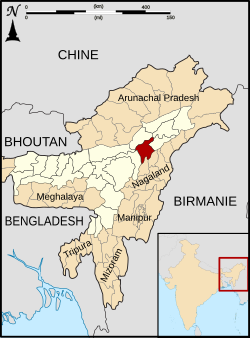Jorhat District
|
Jorhat district যোৰহাট জিলা
|
|||||
|---|---|---|---|---|---|
| District of Assam | |||||
 Location of Jorhat district in Assam |
|||||
| Country | India | ||||
| State | Assam | ||||
| Headquarters | Jorhat | ||||
| Tehsils | 1. Jorhat East, 2. Jorhat West, 3. Titabor, 4. Teok, 5. Mariani, | ||||
| Government | |||||
| • Lok Sabha constituencies | 1. Jorhat | ||||
| • Assembly seats | 1. Jorhat, 2. Titabor, 3. Mariani, 4. Teok, 5. Dergaon | ||||
| Area | |||||
| • Total | 2,852 km2 (1,101 sq mi) | ||||
| Population (2011) | |||||
| • Total | 1,091,295 | ||||
| • Density | 380/km2 (990/sq mi) | ||||
| Demographics | |||||
| • Literacy | 83.42 % | ||||
| • Sex ratio | 956 female per 1000 male | ||||
| Major highways | NH-37 | ||||
| Website | Official website | ||||
| Jorhat district | |
|---|---|
 |
Jorhat {Pron:ˈʤɔ:(r)ˌhɑ:t} is an administrative district of Assam, located in the central part of Brahmaputra Valley. The district is bounded by Lakhimpur district on north, Nagaland state on the south, Sivasagar on the east and Golaghat on the west. On the North of the district, the river Brahmaputra forms the largest riverine island of the world. The administrative seat is located at Jorhat town.
Earlier Jorhat was a sub-division of undivided Sibsagar district. In 1983 Jorhat was carved out of Sibsagar District and was made a separate district.
"Jorhat" or "Jorehaut" means two hats or mandis- “Macharhat” and “Chowkihat” which existed on the two different banks of the river Bhugdoi during the 18th century.
The northern most area of the present district was a part of the Sutiya Kingdom before the Ahom-Sutiya war in the 16th century. In 1794 the Ahom king Gaurinath Singha shifted the capital from Sibsagar (erstwhile ”Rangpur”) to Jorhat. This town was a flourishing and commercial metropolis but completely destroyed after a series of the Burmese invasions since 1817 till the arrival of the British force in 1824 under the Stewardship of David Scott and Captain Richard.
The British rule, though, was not free from rebellions and revolutions, contributed to reemergence of this historical town. From the very first decade of the British rule, the great revolutionists who emerged were Gomdhar Konwar, Jeuram and Piyali, British system of administration, came into vogue in 1839 with an established Police Thana. During the great “Sepoy Mutiny” the anti-British plot hatched by Maniram Dewan and Piyali Barua was sabotaged, and these leaders were hanged in public at this very place in 1858.
In 1885, a narrow-gauge train service (Jorhat Provincial Railway) had come into operation and ultimately became instrumental in rapid growth of tea industry.
...
Wikipedia
